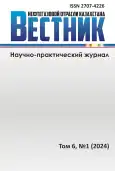Calculation of the characteristics of rock samples based on their images using deep machine learning algorithms
- Authors: Assilbekov B.K.1,2, Kalzhanov N.E.3,4, Bekbau B.E.2, Bolysbek D.A.1,2
-
Affiliations:
- U.A. Joldasbekov Institute of Mechanics and Engineering
- Satbayev University
- KBTU BIGSoft
- Al-Farabi Kazakh National University
- Issue: Vol 6, No 1 (2024)
- Pages: 36-49
- Section: Geology
- URL: https://journal-vniispk.ru/2707-4226/article/view/254085
- DOI: https://doi.org/10.54859/kjogi108674
- ID: 254085
Cite item
Full Text
Abstract
Porosity, absolute permeability and diffusion coefficient are important characteristics of the flow of fluids in the pore space of rocks, the determination of which is resource-intensive and time-consuming. With the development of deep machine learning methods over the past 3–4 years, artificial neural networks have begun to be actively used in determining the transport properties of the “liquid-porous medium” system and the geometric characteristics of the pore space of samples based on their images. This method allows you to quickly determine the desired properties with acceptable accuracy. Therefore, the question arises about the effectiveness and adequacy of deep machine learning methods for these purposes.
This article provides a scientific review of open literature sources on the determination of absolute permeability, diffusion coefficient and porosity from images obtained by different scanning methods. We also used our own data, namely images for 4 carbonate samples, and presented the results of predicting the connected porosity of these samples based on their X-ray images using the convolutional neural network model we built.
The review showed that images of rock samples obtained using various scanning methods make it possible to calculate their transport properties with high reliability in a significantly short time. This means that deep machine learning can be a good alternative tool for calculating the properties of rock samples based on their images. The model we built showed the predictive ability of the porosity of 3 carbonate samples with a reliability coefficient of 0.936–0.976.
Full Text
##article.viewOnOriginalSite##About the authors
Bakytzhan K. Assilbekov
U.A. Joldasbekov Institute of Mechanics and Engineering; Satbayev University
Email: assibekov.b@gmail.com
ORCID iD: 0000-0002-0368-0131
PhD
Kazakhstan, Almaty; AlmatyNurlykhan E. Kalzhanov
KBTU BIGSoft; Al-Farabi Kazakh National University
Email: nurkal022@gmail.com
ORCID iD: 0009-0008-5776-0971
Kazakhstan, Almaty; Almaty
Bakbergen E. Bekbau
Satbayev University
Author for correspondence.
Email: bakbergen.bekbau@gmail.com
ORCID iD: 0000-0003-2410-1626
PhD
Kazakhstan, AlmatyDarezhat A. Bolysbek
U.A. Joldasbekov Institute of Mechanics and Engineering; Satbayev University
Email: bolysbek.darezhat@gmail.com
ORCID iD: 0000-0001-8936-3921
Kazakhstan, Almaty; Almaty
References
- Rajalingam B, Priya R. Multimodal Medical Image Fusion based on Deep Learning Neural Network for Clinical Treatment Analysis. Int J ChemTech Res. 2018;11(6):160–176. doi: 10.20902/IJCTR.2018.110621.
- Cicceri G, Inserra G, Limosani M. A Machine Learning Approach to Forecast Economic Recessions – An Italian Case Study. Mathematics. 2020;8(2). doi: 10.3390/math8020241.
- Yoon J. Forecasting of Real GDP Growth Using Machine Learning Models: Gradient Boosting and Random Forest Approach. Comput Econ. 2021;57(1):247–265. doi: 10.1007/s10614-020-10054-w.
- Gholami R, Shahraki AR, Jamali Paghaleh M. Prediction of Hydrocarbon Reservoirs Permeability Using Support Vector Machine. Math Probl Eng. 2012:1–18. doi: 10.1155/2012/670723.
- Waszkiewicz S, Krakowska-Madejska P, Puskarczyk E. Estimation of absolute permeability using artificial neural networks (multilayer perceptrons) based on well logs and laboratory data from Silurian and Ordovician deposits in SE Poland. Acta Geophys. 2019;67:1885–1894. doi: 10.1007/s11600-019-00347-6.
- Tembely M, AlSumaiti AM, Alameri W. A deep learning perspective on predicting permeability in porous media from network modeling to direct simulation. Comput. Geosci. 2020;24(4):1541–1556. doi: 10.1007/s10596-020-09963-4.
- Xuan YM, Zhao K, Li Q. Investigation on mass diffusion process in porous media based on Lattice Boltzmann method. Heat Mass Transf. 2010;46(10):1039–1051. doi: 10.1007/s00231-010-0687-2.
- Wang Y, Lin G. Efficient deep learning techniques for multiphase flow simulation in heterogeneous porousc media. J Comput Phys. 2020;401. doi: 10.1016/j.jcp.2019.108968.
- Santos JE, Xu D, Jo H, et al. PoreFlow-Net: A 3D convolutional neural network to predict fluid flow through porous media. Adv Water Resour. 2020;138. doi: 10.1016/j.advwatres.2020.103539.
- Da Wang Y, Blunt MJ, Armstrong RT, Mostaghimi P. Deep learning in pore scale imaging and modeling. Earth-Science Rev. 2021;215. doi: 10.1016/j.earscirev.2021.103555.
- Bolysbek DA, Kulzhabekov AB, Bekbau B, Uzbekaliyev KS. Study of the pore structure and calculation of macroscopic characteristics of rocks based on X-ray microcomputed tomography images. Kazakhstan J oil gas Ind. 2023;5(2):17–30. doi: 10.54859/kjogi108647. (In Russ).
- Tian J, Qi C, Sun Y, et al. Permeability prediction of porous media using a combination of computational fluid dynamics and hybrid machine learning methods. Eng Comput. 2021;37:3455–3471. doi: 10.1007/s00366-020-01012-z.
- Graczyk KM, Matyka M. Predicting porosity, permeability, and tortuosity of porous media from images by deep learning. Sci Rep. 2020;10. doi: 10.1038/s41598-020-78415-x.
- Caglar B, Broggi G, Ali MA, et al. Deep learning accelerated prediction of the permeability of fibrous microstructures. Compos Part A Appl Sci Manuf. 2022;158. doi: 10.1016/j.compositesa.2022.106973.
- Araya-Polo M, Alpak FO, Hunter S, et al. Deep learning–driven permeability estimation from 2D images. Comput Geosci. 2020;24:571–580. doi: 10.1007/s10596-019-09886-9.
- Wang H, Yin Y, Hui XY, et al. Prediction of effective diffusivity of porous media using deep learning method based on sample structure information self-amplification. Energy AI. 2020;2. doi: 10.1016/j.egyai.2020.100035.
- Tembely M, AlSumaiti AM, Alameri WS. Machine and deep learning for estimating the permeability of complex carbonate rock from X-ray micro-computed tomography. Energy Reports. 2021;7:1460–1472. doi: 10.1016/j.egyr.2021.02.065.
- Wu H, Fang W-Z, Kang Q, et al. Predicting Effective Diffusivity of Porous Media from Images by Deep Learning. Sci Rep. 2019;9. doi: 10.1038/s41598-019-56309-x.
- Graczyk KM, Strzelczyk D, Matyka M. Deep learning for diffusion in porous media. Sci Rep. 2023;13. doi: 10.1038/s41598-023-36466-w.
- Tang P, Zhang D, Li H. Predicting permeability from 3D rock images based on CNN with physical information. J Hydrol. 2022;606. doi: 10.1016/j.jhydrol.2022.127473.
- Zhang H, Yu H, Yuan X, et al. Permeability prediction of low-resolution porous media images using autoencoder-based convolutional neural network. J Pet Sci Eng. 2022;208. doi: 10.1016/j.petrol.2021.109589.
- Alqahtani N, Alzubaidi F, Armstrong RT, et al. Machine learning for predicting properties of porous media from 2d X-ray images. J Pet Sci Eng. 2020;184. doi: 10.1016/j.petrol.2019.106514.
Supplementary files















